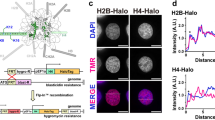Abstract
Movement of labelled plasmid DNA relative to heterochromatin foci in nuclei, visualized with HP1-GFP, was studied using live-cell imaging and object tracking. In addition to Brownian motion of plasmid DNA we found a pronounced, non-random movement of plasmid DNA towards the nearest HP1 focus, while time-lapse microscopy showed that HP1 foci are relatively immobile and positionally stable. The movement of plasmid DNA was much faster than that of the HP1 foci. Contact of transgene DNA with an HP1 focus usually resulted in cessation of the directional motion. Moreover, the motion of plasmid DNA inside the heterochromatin compartment was more restricted (limited to 0.25 μm) than when the plasmid DNA was outside heterochromatin (R = 0.7 μm). Three days after transfection most of the foreign labelled DNA colocalized with centromeric heterochromatin.
Similar content being viewed by others
References
Aagaard L, Laible G, Selenko P et al. (1999) Functional mammalian homologues of the Drosophila PEV-modifier Su(var)3–9 encode centromere-associated proteins which complex with the heterochromatin component M31. EMBO J 18: 1923–1938.
Bannister AJ, Zegerman P, Partridge JF et al. (2001) Selective recognition of methylated lysine 9 on histone H3 by the HP1 chromo domain. Nature 410: 120–124.
Bártová E, Kozubek S, Jirsová P et al. (2002) Nuclear structure and gene activity in human differentiated cells. J Struct Biol 139: 76–89.
Berger SL (2001) An embarrassment of niches: the many covalent modifications of histones in transcriptional regulation. Oncogene 20: 3007–3013.
Brown KE, Guest SS, Smale ST, Hahm K, Merkenschlager M, Fisher AG (1997) Association of transcriptionally silent genes with Ikaros complexes at centromeric heterochromatin. Cell 91: 845–854.
Cheutin T, McNairn AJ, Jenuwein T, Gilbert DM, Singh PB, Misteli T (2003) Maintenance of stable heterochromatin domains by dynamic HP1 binding. Science 299: 721–725.
Chubb JR, Boyle S, Perry P, Bickmore WA (2002) Chromatin motion is constrained by association with nuclear compartments in human cells. Curr Biol 12: 439–445.
Clubb BH, Locke M (1998) Peripheral nuclear matrix actin forms perinuclear shells. J Cell Biochem 70: 240–251.
Cryderman DE, Morfia EJ, Biessmann H, Elgin SC, Wallrath LL (1999) Silencing at Drosophila telomeres: nuclear organization and chromatin structure play critical roles. EMBO J 18: 3724–3735.
Dillon N, Festenstein R (2002) Unravelling heterochromatin: competition between positive and negative factors regulates accessibility. Trends Genet 18: 252–258.
Dobie KW, Lee M, Fantes JA et al. (1996) Variegated transgene expression in mouse mammary gland is determinated by the transgene integration locus. Proc Natl Acad Sci USA 93: 6659–6664.
Festenstein R, Pagakis SN, Hiragami K et al. (2003) Modulation of heterochromatin protein 1 dynamics in primary mammalian cells. Science 269: 1429–1431.
Francastel C, Walter MC, Groundine M, Martin DIK (1999) A functional enhancer suppresses silencing of a transgene and prevents its localization close to centromeric heterochromatin. Cell 99: 259–269.
Francastel C, Schubeler D, Martin DI, Groudine M (2000) Nuclear compartmentalization and gene activity. Nat Rev Mol Cell Biol 1: 137–143.
Friend DS, Papahadjopoulos D, Debs RJ (1996) Endocytosis and intracellularprocessing accompaning transfection mediated by cationic liposomes. Biochim Biophys Acta 1278: 41–50.
Gilbert N, Allan J (2001) Distinctive higher-order chromatin structure at mammalian centromeres. Proc Natl Acad Sci USA 98: 11949–11954.
Görisch SM, Wachsmuth M, Ittrich C, Bacher CP, Rippe K, Lichter P (2004) Nuclear body movement is determined by chromatin accessibility and dynamics. Proc Natl Acad Sci USA 101: 13221–13226.
Hayakawa T, Haraguchi T, Masumoto H, Horaoka Y (2003) Cell cycle behavior of human HP1 subtypes: distinct molecular domains of HP1 are required for thein centromeric localization dutiny interphase and metaphase. J Cell Sci 116: 3327–3338.
Hofmann W, Stojiljkovic L, Fuchsova B et al. (2004) Actin is part of pre-initiation complexes and is necessary for transcription by RNA polymerase II. Nat Cell Biol 6: 1094–1101.
Howe M, Dimitri P, Berloco M, Wakimoto BT (1995) Cis-effects of heterochromatin on heterochromatic and euchromatic gene activity in Drosophila melanogaster. Genetics 140: 1033–1045.
Jenuwein T, Allis CD (2001) Translating the histone code. Science 293: 1074–1080.
Johnson L, Jurcisek JA (1999) A method to monitor DNA transfer during transfection. AAPS Pharmsci 1(3): 1–7.
Kashihara N, Maeshima Y, Makino H (1998) Antisense oligonucleotides. Exp Nephrol 6: 84–88.
Kimura T, Hashimoto I, Yamamoto A, Nishikawa M, Fujisawa JI (2000) Rev-dependent association of the intron-containing HIV-1 gag mRNA with the nuclear actin bundles and the inhibition of its nucleocytoplasmic transport by latrunculin-B. Genes Cells 5: 289–307.
Kozubek M, Matula Pe, Matula Pa, Kozubek S (2004) Automated acquisition and processing of multidimensional image data in confocal in vivo microscopy. Microsci Res Tech 64: 164–175.
Lukacs GL, Haggie P, Seksek O, Lecherdeur D, Freedman N, Verkman AS (2000) Size-dependent DNA mobility in cytoplasm and nucleus. J Biol Chem 275: 1625–1629.
Ma H, Siegel AJ, Berezney R (1999) Association of chromosome territories with nuclear matrix: disruption of human chromosome territories correlates with the release of subset of nuclear matrix proteins. J Cell Biol 146: 531–541.
Mearini G, Nielsen PE, Fackelmayer FO (2004) Localization and dynamics of small circular DNA in live mammalian nuclei. Nucleic Acids Res 32: 2642–2651.
Mutskov V, Felsenfeld G (2004) Silencing of transgene transcription precedes methylation of promoter DNA and histone H3 lysine 9. EMBO J 23: 138–149.
Pederson T (2000) Half a century of ‘the nuclear matrix’. Mol Biol Cell 11: 799–805.
Porteus MH, Canthomen T, Weitzman MD, Baltimore D (2003) Efficient gene targeting mediated by adeno-associated virus and DNA double-strand breaks. Mol Cell Biol 23: 3558–3565.
Verkman AS (2002) Solute and macromolecule diffusion in cellular aqueous compartments. Trends Biochem Sci 27: 27–33.
Verschure PJ, van der Kraan I, de Leeuw W et al. (2005) In vivo HP1 targeting causes large-scale chromatin condensation and enhanced histone lysine methylation. Mol Cell Biol 25: 4552–4564.
Xu Y, Szoka FC (1996) Mechanism of DNA release in cationic liposomemediated gene transfection. Biochemistry 35: 5616–5623.
Author information
Authors and Affiliations
Corresponding author
Rights and permissions
About this article
Cite this article
Ondřej, V., Kozubek, S., Lukášová, E. et al. Directional motion of foreign plasmid DNA to nuclear HP1 foci. Chromosome Res 14, 505–514 (2006). https://doi.org/10.1007/s10577-006-1058-1
Received:
Revised:
Accepted:
Published:
Issue Date:
DOI: https://doi.org/10.1007/s10577-006-1058-1




